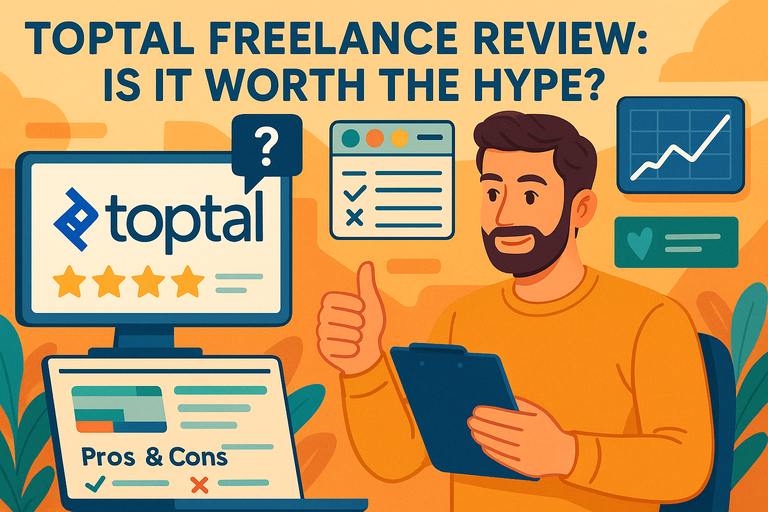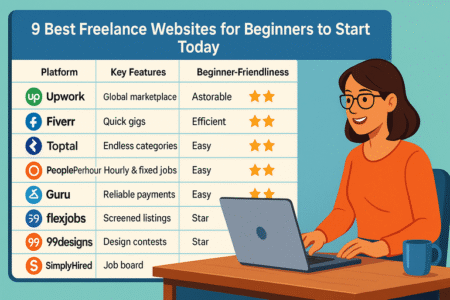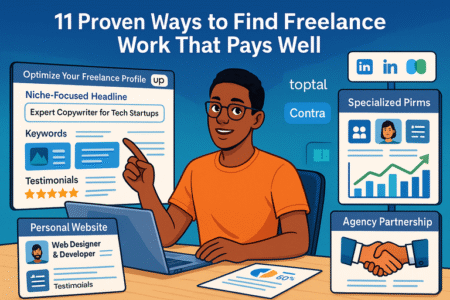Table of Contents
Toptal freelance has been popping up everywhere as the go-to platform for top-tier talent, but is it really worth all the hype? If you’ve been wondering whether this exclusive network is right for you—whether as a freelancer trying to get in, or a business considering hiring from it—you’re in the right place.
In this review, I’ll break down what makes Toptal stand out, where it falls short, and whether it lives up to its promise of connecting only the top 3% of freelancers.
What Makes Toptal Freelance Different From Other Platforms?
Toptal freelance is often called the “exclusive club” of the freelance world, but what exactly sets it apart from places like Upwork or Fiverr?
At its core, it comes down to how carefully Toptal screens freelancers and how that changes the experience for both clients and talent.
The Strict Vetting Process Explained
Unlike most freelance platforms where anyone can create a profile and start bidding for jobs, Toptal puts up a very tall gate. Every applicant goes through a multi-step screening process that filters out more than 95% of people who apply.
Here’s a breakdown of how Toptal vets candidates:
- Language and communication check: They assess your English fluency, since clients expect clear communication.
- In-depth skill tests: Think of this as a coding challenge, design project, or finance case study depending on your field.
- Live screening: A real-time session with a Toptal expert where you solve problems on the spot.
- Trial project: A short but realistic client project to prove you can deliver high-quality work.
This process means fewer freelancers are accepted, but those who do make it in often stand out as highly skilled and reliable.
From what I’ve seen, that’s both intimidating and motivating—if you get in, you instantly differentiate yourself from the crowd.
How the “Top 3%” Claim Impacts Freelancers and Clients
Toptal markets itself as hosting the “top 3%” of freelance talent. While that number is more of a branding hook than a literal metric, it does shape the way people see the platform.
For freelancers, the label carries weight. If you can say you’re in Toptal’s network, it adds credibility to your profile everywhere else. Clients are more likely to trust you right away because they know you’ve already been tested.
For clients, the “3%” promise sets expectations: they’re not browsing through endless profiles; instead, they’re matched with vetted professionals quickly. It reduces the risk of hiring the wrong person, which can be very expensive for a startup or enterprise project.
Of course, this exclusivity also has a downside: great talent may be overlooked simply because they didn’t shine in a live test environment. But overall, the top-3% angle helps Toptal stand apart in a crowded freelance market.
Why Businesses Choose Toptal Over Alternatives
Companies don’t just flock to Toptal for its marketing. They’re drawn in because of the consistency and reliability that comes from strict screening.
Here’s what usually convinces businesses to pick Toptal:
- Quality over quantity: Instead of sifting through 50 proposals like on Upwork, a client gets a shortlist of pre-vetted experts.
- Speed of hiring: Toptal claims it can match businesses with a freelancer in as little as 48 hours.
- Long-term value: Many projects extend into multi-year contracts, giving businesses confidence they won’t need to constantly rehire.
To put it in perspective: imagine a CTO needing a machine learning engineer. On Fiverr, they might scroll endlessly, hoping reviews are real.
On Upwork, they’ll likely interview five to ten candidates. On Toptal, they may get two names—and both are solid choices. That time savings is why companies are willing to pay higher rates.
How the Toptal Application Process Really Works
Getting into Toptal freelance isn’t like setting up a profile elsewhere. It’s more like going through a rigorous job interview at a top tech company.
The process itself has become a bit of a legend in the freelance world, so let’s break it down step by step.
Step-By-Step Breakdown of the Screening Rounds
Toptal’s application pipeline usually follows these stages:
- Initial application – You submit your experience, portfolio, and resume. If it doesn’t align with in-demand roles, you might be filtered out here.
- Language and communication test – A short interview where they gauge fluency, clarity, and ability to explain concepts.
- Skill assessments – Timed tests or portfolio reviews specific to your field (developers may face algorithm challenges, designers may be asked to create wireframes).
- Live screening – A real-time problem-solving call with a Toptal interviewer. Think of it as a coding whiteboard session or strategy case study.
- Trial project – A short assignment that mimics real client work. This is often the make-or-break step.
Each stage is designed to knock out a large chunk of applicants. According to Toptal, only 3–5% make it through.
Skills Testing and Live Screening: What to Expect
The live screening is one of the most nerve-wracking parts. It’s not about showing a polished portfolio—it’s about proving you can think out loud under pressure.
For example:
- Developers might get a problem like “optimize this search algorithm” and have to code live while explaining choices.
- Designers could be asked to create a quick wireframe for a new app feature.
- Finance experts may be asked to walk through a financial model and explain assumptions.
The key here is clarity. Interviewers want to see how you approach problems, not just whether you land on the perfect answer. If you freeze under pressure, it can hurt your chances. My advice? Treat it like you’re collaborating with a teammate, not taking a test.
Common Reasons Applicants Get Rejected
Most freelancers don’t fail because they’re terrible—they fail because Toptal is looking for something very specific. Common reasons for rejection include:
- Weak communication skills: Even brilliant developers get filtered out if they can’t explain concepts clearly in English.
- Overconfidence or under-preparation: Some applicants underestimate the difficulty of the tests.
- Portfolio gaps: If you can’t back up your skills with solid, recent work, Toptal might see you as a risk.
- Struggling in trial projects: Delivering late or producing sloppy work during the final step is an automatic rejection.
From what I’ve seen, freelancers who prepare by practicing mock interviews, updating portfolios, and brushing up on fundamentals have a much higher chance of passing.
The Types of Freelance Jobs Available on Toptal
Toptal freelance jobs aren’t as broad as what you’ll find on platforms like Fiverr or Upwork.
Instead, Toptal focuses on a smaller set of high-demand industries where clients need expert-level work.
Industries and Roles With the Highest Demand
From what I’ve seen, Toptal’s strongest categories are:
- Software development: Full-stack developers, backend specialists (Python, Node.js, Java), mobile app developers, and DevOps engineers.
- Design: UX/UI designers, product designers, and visual branding experts.
- Finance: Financial modeling, investment analysis, and fractional CFO services.
- Project and product management: Agile project managers, Scrum Masters, and product owners.
These are industries where mistakes are expensive, so clients prefer vetted experts.
For example, a fintech startup might hire a Toptal developer to build a payment gateway that has to be secure and scalable—something too risky to give to an untested freelancer.
Long-Term vs. Short-Term Projects on the Platform
Toptal offers both short gigs and ongoing engagements, but the platform leans more toward longer-term work.
- Short-term projects: Usually proof-of-concept apps, quick design revamps, or financial forecasts for investors.
- Long-term projects: Multi-month software builds, ongoing product management, or continuous UX design improvements.
One thing clients like is that they can scale a relationship. For example, a startup might start with a 2-week trial project with a developer.
If that goes well, it often evolves into a 12-month contract. This kind of continuity is rare on platforms like Fiverr, where most jobs are one-offs.
How Niche Skills Can Give You an Edge
Being generalist on Toptal is tougher, but having a niche skill set can really boost your chances of both getting accepted and landing work.
For example:
- A developer with deep expertise in machine learning for healthcare data is more likely to stand out than a general full-stack dev.
- A designer who specializes in SaaS onboarding flows can carve out a strong demand niche.
- A finance expert focused on crypto assets can win contracts in emerging industries.
I suggest highlighting these niche strengths in your portfolio. Toptal clients aren’t just browsing for “a developer.” They want the right developer for a very specific business problem.
Toptal Pricing: What Clients and Freelancers Should Know
Pricing is one of the first questions people ask about Toptal freelance work. It’s also one of the biggest reasons both clients and freelancers hesitate before diving in.
How Much Clients Pay to Use Toptal Talent
Clients typically pay higher rates on Toptal than on platforms like Upwork, but they’re paying for peace of mind.
- Hourly rates: Developers and designers generally start around $60–$120/hr, while senior experts can charge $150/hr and above.
- Weekly retainers: Some projects shift to weekly retainers ranging from $2,000–$4,000.
- Client deposit: New clients usually make an upfront deposit (around $500), which is applied to the first invoice.
Compared to the chaos of lower-cost marketplaces, this pricing structure weeds out bargain-hunting clients and ensures freelancers get serious work.
What Freelancers Can Expect to Earn
For freelancers, the higher barrier to entry is offset by the earning potential once inside.
- Developers often report rates 2–3x higher than what they could negotiate on Upwork.
- Designers and finance experts can land multi-month projects with steady income, which feels closer to a full-time contract than gig work.
- Payments are handled directly through Toptal’s system, usually via direct deposit or Payoneer, and I’ve noticed payments are far more reliable than what you’d find chasing down invoices elsewhere.
I suggest treating Toptal less like a side hustle and more like a career step. If you’re accepted, you can replace multiple small gigs with one or two high-paying, consistent clients.
Comparing Toptal Rates to Other Marketplaces
Here’s a quick side-by-side to put Toptal pricing in context:
| Platform | Typical Rates for Developers | Client Experience | Screening Level |
| Toptal | $60–$150+/hr | Curated matches in 48 hrs | Very strict |
| Upwork | $20–$80/hr | Open marketplace | Light vetting |
| Fiverr Pro | $50–$100/hr | Pre-vetted, still crowded | Moderate vetting |
| Freelancer | $15–$50/hr | Bid-based, high variance | Minimal vetting |
Clients pay more on Toptal, but they save time and reduce risk. Freelancers earn more but must clear a very high bar to get in.
Benefits of Joining Toptal Freelance Network
The benefits of Toptal freelance go beyond just higher pay. Once you’re inside, you gain access to a professional environment that feels more like an exclusive consultancy than a typical gig platform.
Access to High-Paying Clients and Stable Work
This is probably the biggest draw. Clients who hire through Toptal aren’t experimenting—they have budgets and serious projects. That means:
- No endless lowball offers.
- Long-term contracts are common.
- Fewer client disputes, since expectations are set up front.
I’ve seen freelancers secure multi-year partnerships with a single client here, something that’s rare on other platforms.
Exclusive Community and Networking Perks
Another under-the-radar benefit is Toptal’s private community. Once accepted, you gain access to:
- Slack channels and forums for networking.
- Exclusive events and webinars where you meet other senior-level professionals.
- Skill development programs to stay current in your industry.
Think of it less like being on a job board and more like joining a professional guild. For many freelancers, the sense of belonging to a vetted peer group is just as valuable as the projects themselves.
Why Toptal Appeals to Senior-Level Talent
Toptal is not the best fit for beginners, and that’s intentional. It’s aimed at freelancers who already have 5–10 years of serious experience and want to:
- Escape low-quality gig marketplaces.
- Charge rates that reflect their expertise.
- Work on projects that challenge them technically or creatively.
For example, a senior backend engineer who’s tired of building basic websites on Upwork can find enterprise-level projects on Toptal—things like scaling cloud infrastructure for a Fortune 500 client.
I believe this is why so many established professionals choose Toptal. It’s not about finding “more gigs.” It’s about elevating freelance work into something that looks and feels like a consulting career.
Drawbacks and Challenges of Using Toptal
Toptal freelance isn’t perfect, and it’s important to see the downsides before you jump in. These challenges affect both freelancers and clients.
The High Barrier to Entry for New Freelancers
The biggest drawback for freelancers is simply getting in. With Toptal’s strict screening, rejection rates are above 90%. That means talented people often get filtered out if they don’t perform well under pressure.
- For example: a great developer who struggles in live whiteboard tests may not pass, even if they’d thrive in real-world projects.
- The process itself can take weeks, which can feel discouraging if you’re applying while also juggling other work.
I suggest practicing mock interviews and timed problem-solving before applying. Think of it less like signing up for a platform and more like preparing for a senior-level job interview.
Limited Opportunities for Beginners or Generalists
Toptal isn’t built for freelancers just starting out or for those with broad but shallow skill sets.
- Beginners: If you don’t have 3–5 years of strong, provable experience, it’s almost impossible to get accepted.
- Generalists: Toptal clients usually want a specialist. For example, instead of hiring a “web developer,” they’ll look for a React.js frontend engineer or Python machine learning expert.
This can be frustrating if you’re still exploring what you want to specialize in. In that case, other platforms like Upwork or Fiverr Pro may be better for building experience.
Why Clients Might Struggle With Higher Costs
Clients also face hurdles on Toptal, mainly around cost.
- Rates are higher than on other platforms. Developers, for example, often cost $80–$150/hr.
- Budget-conscious startups may feel priced out. A small business might balk at paying $3,000 for work they can outsource elsewhere for $800.
- Less flexibility: Since projects lean toward long-term, it may not be the best choice for one-off, experimental tasks.
That said, businesses that value quality and speed often see the cost as worthwhile because it reduces the risk of a failed project.
Alternatives to Toptal Freelance You Should Consider
Toptal freelance isn’t the only option. Depending on your experience or budget, you might find a better fit elsewhere.
Upwork: Best for Volume and Flexibility
Upwork is the biggest open freelance marketplace, with millions of freelancers and projects.
- Pros: Huge variety of jobs, flexible budgets, and faster onboarding (you can start applying immediately).
- Cons: Fierce competition, with clients often focused on cost rather than quality.
If you’re still building a portfolio, Upwork can be a great training ground. You can find everything from $50 logo gigs to $100k app builds, but you’ll need persistence to cut through the noise.
Fiverr Pro: A Curated Marketplace With Lower Barriers
Fiverr Pro is Fiverr’s premium offering, where freelancers go through a vetting process (though not nearly as strict as Toptal).
- Pros: Easier acceptance process, curated projects, and the Fiverr brand brings lots of client traffic.
- Cons: Still more transactional, with fewer long-term relationships than Toptal.
I think Fiverr Pro is a good middle ground: if you want some level of credibility boost but aren’t ready for Toptal’s extreme screening, it’s worth considering.
Gun.io and Arc.dev: Other Premium Talent Platforms
Both Gun.io and Arc.dev position themselves similarly to Toptal, offering vetted talent to businesses.
- Gun.io: Focused mostly on developers, with a faster hiring process for clients.
- Arc.dev: Offers remote jobs and freelance contracts, with a strong emphasis on long-term relationships.
These platforms are smaller than Toptal but can be great alternatives for freelancers who want curated opportunities without quite as high of a barrier.
Who Should (and Shouldn’t) Use Toptal Freelance
Not every freelancer or business will benefit equally from Toptal. Knowing if it’s the right fit is half the battle.
Ideal Freelancers Who Thrive on Toptal
Toptal works best for professionals who:
- Have 5–10+ years of experience in their field.
- Specialize in high-demand skills like AI, fintech, UX/UI design, or advanced software development.
- Are comfortable with long-term projects and can commit to client schedules.
If you’re already working at a senior level, Toptal can transform your freelance career into something closer to consulting.
Types of Businesses That Benefit Most From Toptal
On the client side, the best fit includes:
- Startups with funding that need to move fast without hiring full-time.
- Enterprises looking for vetted contractors who can plug into big projects.
- Tech companies needing niche expertise (like blockchain development or advanced data science).
For example, a VC-backed SaaS startup might hire a Toptal UX designer to improve onboarding because every extra click could mean losing customers.
When to Look Elsewhere for Better Fit
Toptal might not be right if:
- You’re a freelancer just starting out with limited portfolio work.
- You’re a small business client with a limited budget.
- You’re looking for short, inexpensive projects like logo design or blog content.
In those cases, platforms like Upwork or Fiverr Pro provide more accessible options.
Expert Tips to Succeed on Toptal Freelance
If you decide to aim for Toptal freelance, there are a few strategies that can really improve your chances of success—both in getting accepted and thriving once you’re inside.
Preparing for the Screening Process Like a Pro
Think of the Toptal application like prepping for a high-stakes job interview.
- Do mock interviews: Practice problem-solving while explaining your thought process out loud.
- Update your portfolio: Highlight recent, relevant work with clear case studies.
- Brush up on fundamentals: Developers should review algorithms, while designers might revisit design systems basics.
I suggest setting aside a couple of weeks just for prep. It can make the difference between rejection and acceptance.
How to Stand Out Once You’re Inside the Network
Getting in is only step one. To succeed, you need to keep building credibility.
- Respond quickly to client requests—speed matters.
- Go above expectations in trial projects to set the tone for long-term work.
- Keep learning: Toptal values freelancers who stay updated on new tech and tools.
One freelancer I spoke with mentioned that simply being the most responsive candidate in their category led to multiple repeat clients.
Building Long-Term Client Relationships on Toptal
The biggest financial wins on Toptal come from long-term contracts, not one-off projects.
- Communicate proactively: Don’t wait for a client to check in—send regular progress updates.
- Deliver reliability: Meeting deadlines consistently is often more valuable to clients than dazzling them once.
- Offer strategic advice: Position yourself as a partner, not just a contractor.
For example, a Toptal finance expert working with a SaaS startup might go beyond financial modeling and suggest cash flow strategies that help secure Series A funding. That kind of input often turns a 3-month gig into a multi-year contract.
Pro tip: Don’t see Toptal freelance as a silver bullet. It’s a powerful platform if you’re already experienced, but the real success comes from how you approach client relationships once you’re inside.






